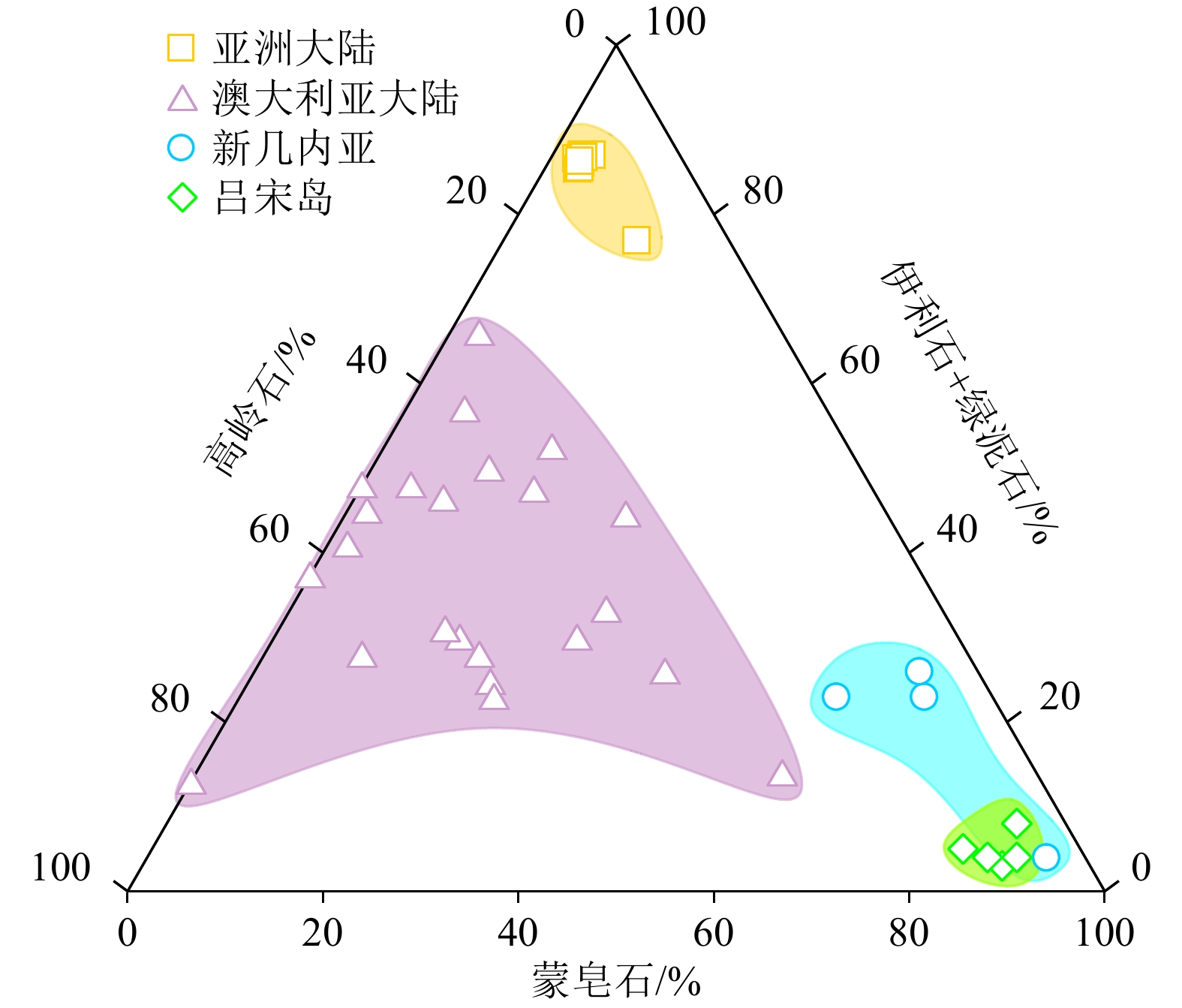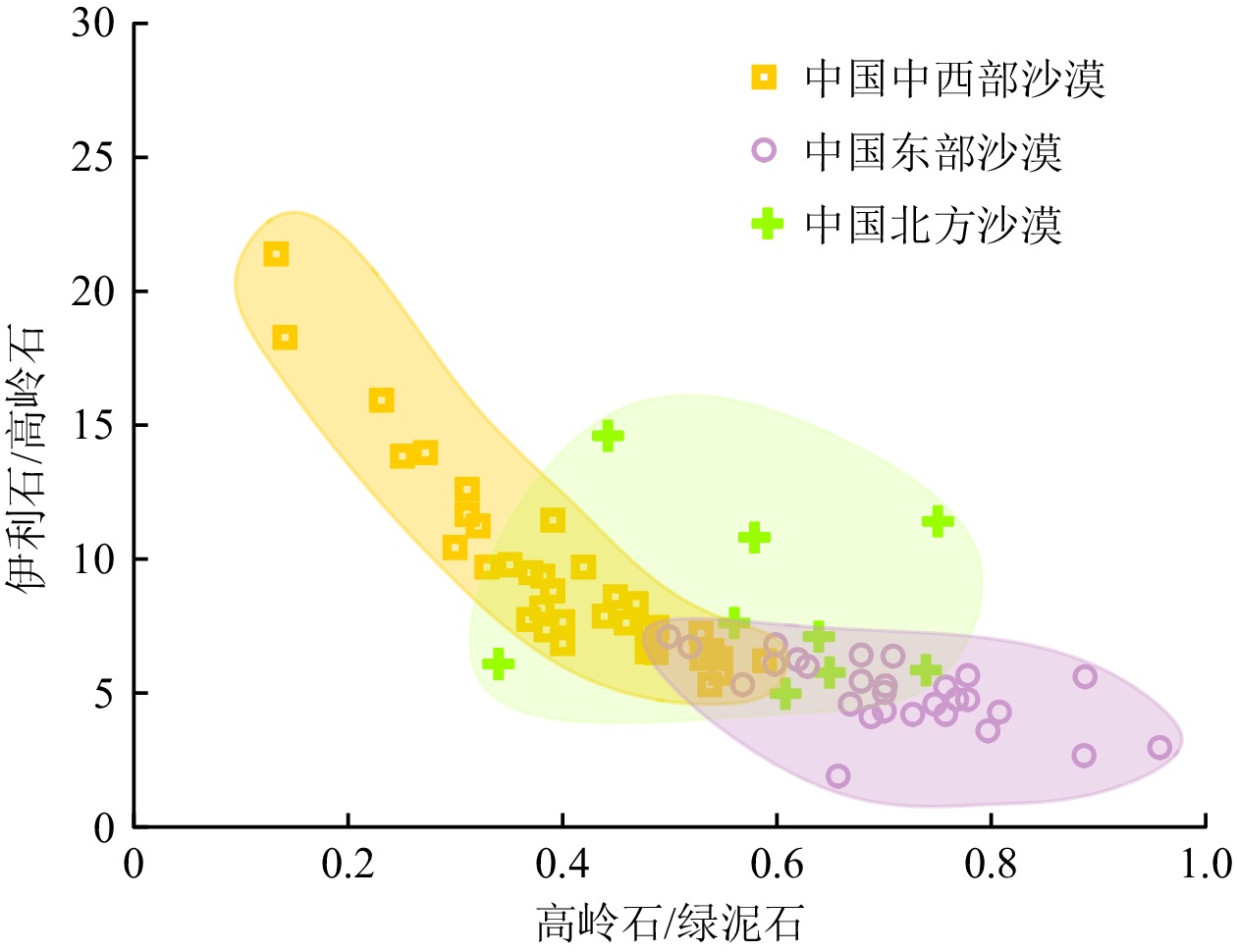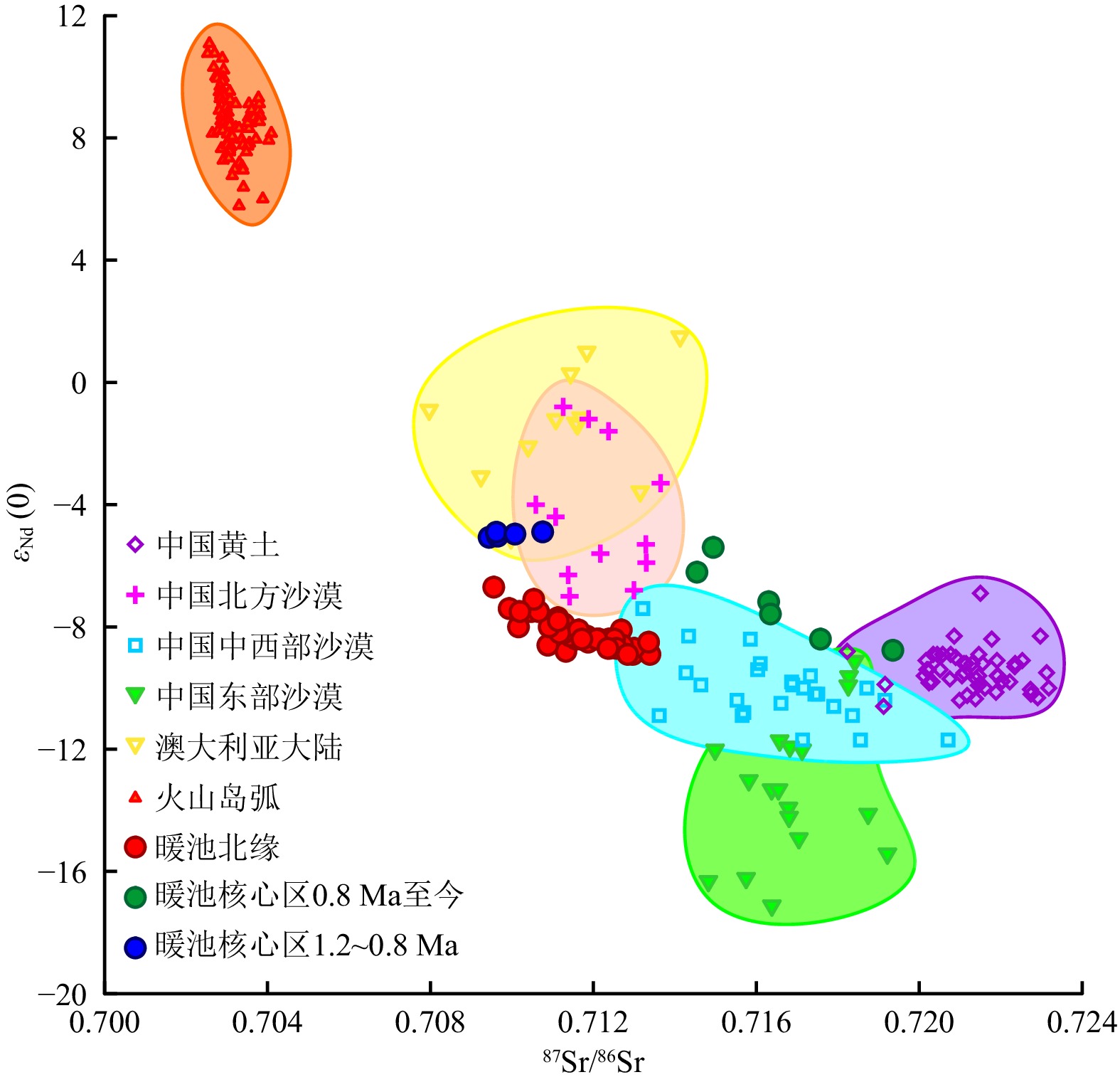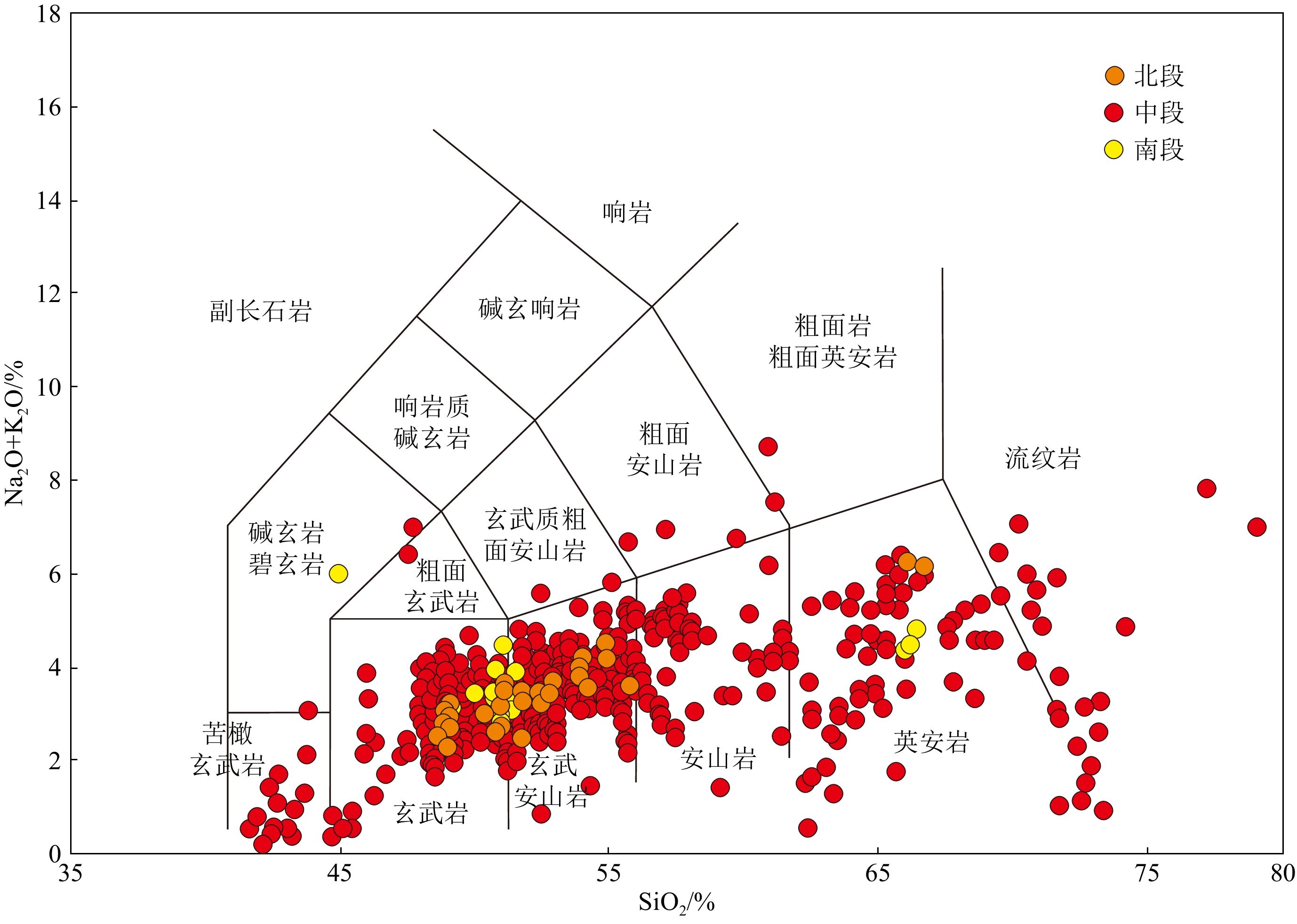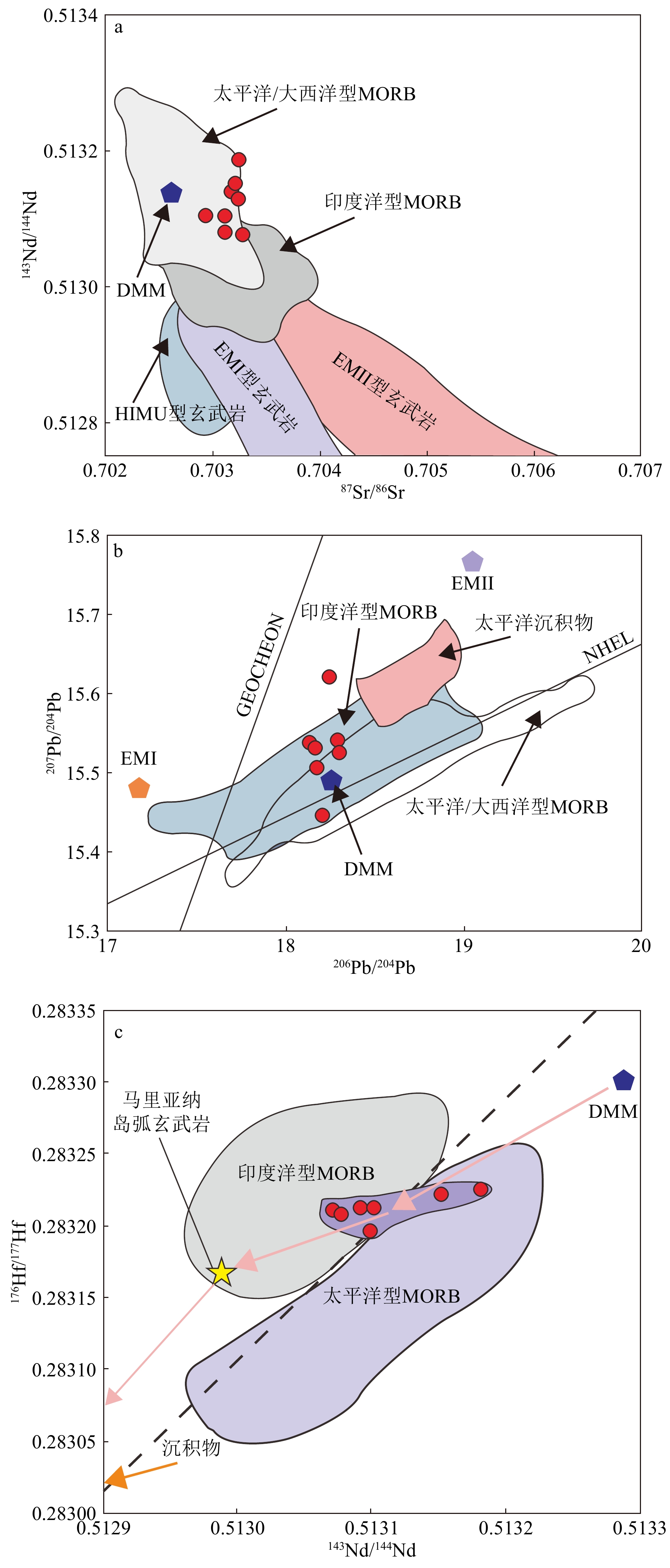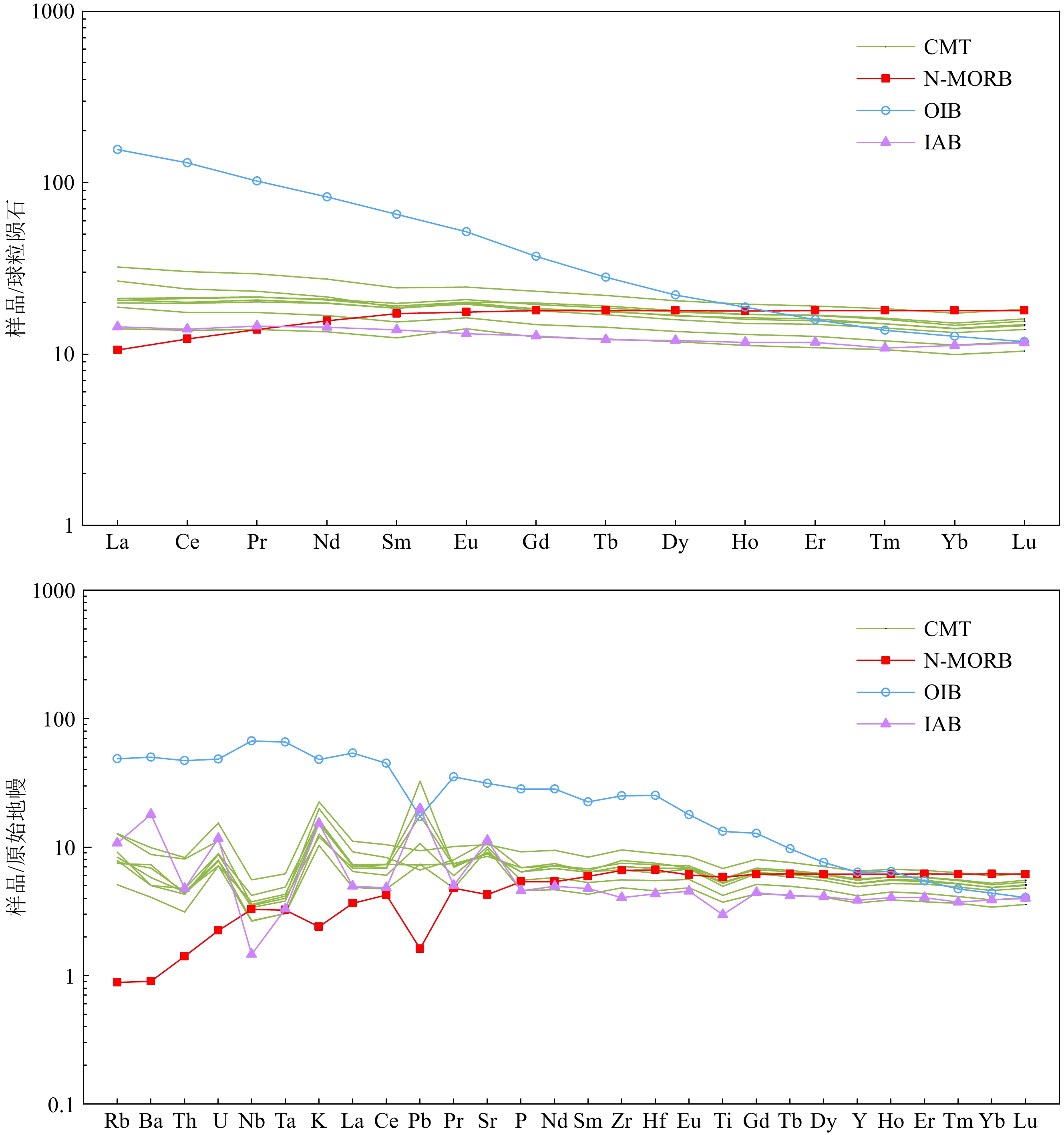Progress of the researches on magmatism in the Mariana Trough
-
摘要: 西太平洋俯冲带是世界上最典型、最活跃的俯冲带,分布众多的海沟-岛弧-弧后盆地(沟弧盆)系统。马里亚纳俯冲带是典型的洋-洋俯冲带,而马里亚纳海槽作为马里亚纳俯冲带的重要构造单元,是研究不受陆壳物质影响的俯冲作用的理想区域。前人对马里亚纳海槽岩浆地幔源区性状、俯冲组分的影响、岩浆演化等进行了详细研究。结果表明:(1) 马里亚纳海槽岩浆源区主要为亏损地幔,岩性主要为橄榄岩,且不同区段具有不一致的地幔部分熔融程度;(2) 不同区段受到来自蚀变洋壳及沉积物的俯冲组分的影响程度也不同,并由此影响了不同区段的地幔熔融程度和初始岩浆成分;(3) 俯冲组分的影响自中段向南北两段逐渐加强,中段主要受到来自沉积物熔体的影响,南、北段受到板片释放的含水流体的影响则更为明显;(4) 不同区段甚至同一区段的岩浆在演化过程中,经历了橄榄石、辉石、斜长石等斑晶矿物的差异性分离结晶过程,这也很好地解释了该区丰富的岩石类型和玄武质岩石的不同矿物组合特征。以上研究很好地促进了对马里亚纳海槽岩浆作用过程的认识,也深化了对俯冲带构造-岩浆作用的理解。Abstract: The Western Pacific subduction zone is one of the most typical and active ones in the world, featuring a vast distribution of trench-island arc-back-arc basin systems. The Mariana subduction zone is a typical ocean-ocean subduction zone, and the Mariana Trough is an important component tectonic unit and an ideal area to elucidate the subduction without the influence of continental crust materials. The magmatic processes of the Mariana Trough were studied in detail, such as rock mantle source properties, subduction components, and magmatic evolution. The research clarified that: (1) the magma source in the Mariana Trough is mostly depleted mantle as it features peridotite dominance and the degree of partial melting of the source mantle varies in different regions. (2) The subduction components from altered oceanic crust and sediments in different parts are affected to different degrees of mantle melting and initial magma composition in different regions. (3) The influence of subduction components gradually increased from the middle section to the north and south sections. The middle section was mainly affected by melt from sediments, and the south and north sections were more significantly affected by hydrous fluids. (4) During the magma evolution in different regions or even in the same region, the fractional crystallization of olivine, pyroxene, and plagioclase can well explain the diverse rock types and different phenocryst assemblages in basaltic rocks. The achievements above could promote the understanding of the magmatism process in the Mariana Trough and also strengthen the deep understanding of tectonic-magmatism in the subduction zone.
-
Keywords:
- mantle melting /
- subduction components /
- magma evolution /
- back-arc basin /
- Western Pacific
-
西太平洋暖池区是全球海洋能量最集中的区域,对调节现代全球气候发挥着极为重要的作用[1-3],同时作为亚洲大陆沉积物重要的“汇”又可以为源区气候变化提供高分辨率且连续的沉积记录。其巨厚的沉积物记录了晚新生代以来众多分辨率较高的海洋环境变化信息(海平面变化、热带辐合带(ITCZ)迁移历史等),使西太平洋暖池区成为研究晚新生代古气候和古环境演化的理想海区。
已有研究者开展了暖池区黏土矿物[4-7]、石英单矿物[8-9]、常量元素[10]、稀土元素[11-13]以及同位素[6, 14-16]等指标的研究,并取得了丰硕的成果(表1,图1)。目前大部分研究者认为暖池区沉积物主要来源于亚洲大陆和火山岛弧,尽管不同区域的具体物源组成往往存在显著差异[7, 16, 17]。目前对暖池区沉积物源区的研究主要集中在北缘和西缘,时间跨度也较短,尚缺乏较长时间跨度的研究(表1)。
表 1 西太平洋暖池区各站位指标信息Table 1. Core locations and palaeoclimate proxies of the Western Pacific Warm Pool sites位置 站号 位置 代用指标 时间跨度 沉积物源区 参考文献 暖池北缘 PC631 12°30′N、134°60′E 黏土矿物 600 ka 亚洲中西部沙漠与火山岛弧 [6] 暖池北缘 MD06-3047 17°00.44′N、124°47.93′E 常量元素 700 ka 火山碎屑物质和陆源风尘物质 [10] 暖池北缘 PV090510 16°47.79′N、138°5.55′E 黏土矿物 1.95 Ma 中亚大陆和马里亚纳岛弧 [5] 暖池北缘 PV090102 17°55.24′N、135°52.68′E Sr-Nd同位素 2.1 Ma 中国中西部沙漠和火山岛弧 [15] 石英 塔克拉玛干沙漠、蒙古戈壁和
火山岛弧[9] 黏土矿物 亚洲大陆和火山岛弧 [4] 黏土矿物 中国黄土和火山岛弧 [20] 暖池北缘 表层 稀土元素 主要来源于周围火山物质,
少部分陆源[13] 暖池北缘 表层 石英 塔克拉玛干沙漠、蒙古戈壁和
火山岛弧[8] 暖池西北缘 Ph05-5 16°2.96′N、124°20.69′E Sr-Nd同位素 50 ka 中国中西部沙漠、中国黄土和吕宋岛 [14] 暖池西缘 DY12 9°11.94′N、136°8.40′E 稀土元素 22 ka 新几内亚和亚洲大陆 [11] 暖池西缘 KX21-2 1°25.01′S、157°58.91′E 黏土矿物 370 ka 新几内亚 [7] 常量元素 380 ka 新几内亚 [17] 暖池西缘 MD06-3050 15°57.09′N、124°46.77′E 黏土矿物 500 ka 中国东部沙漠、黄土和火山岛弧 [21] 暖池西缘 U1489 02°07.19′ N、141°01.67′E 常量元素、稀土元素 4 Ma 主要来源于新几内亚 [12] 暖池西缘 ODP 768
ODP 769
ODP 7718°N、121°13.158′ E
8°47.136′N、121°17.652′E
8°40.692′N、120°40.782′ ESr-Nd同位素 亚洲大陆和火山岛弧 [22] 暖池西缘 表层 87Sr/ 86Sr 亚洲大陆和火山岛弧 [23] 暖池核心 PC932 5°53’N、177°26’W Sr-Nd同位素 1.1 Ma 1.2~0.9 Ma:澳大利亚大陆和中南美洲;
0.9~0.8 Ma:亚洲大陆[16] 几乎整个
暖池区DSDP 65 04°21.21'N、176°59.16'E 常量元素、稀土元素 只给出数据,未分析源区 [24] DSDP 76 14°05.90'S、145°39.64'W DSDP 166 03°45.70'N、175°04.80'W DSDP 199 13°30.80'N、156°10.30'E DSDP 288 05°58.35'S、161°49.53'E DSDP 317 11°00.09'S、162°15.78'W ODP 807 03°36.42'N、156°37.49'E ODP 869 11°00.09'N、164°44.97'E KH68-4-18-3 01°59.5'N、170°00.5'W KH68-4-20-2 02°28.4'S、169°59.7'W KH71-5-10-2 04°58.5'S、146°03.5'W KH71-5-12-3 11°01.4'S、146°01.5'W KH73-4-5 12°23.2'N、151°48'E KH73-4-9 07°49.9'S、172°48.6'E KH80-3-30 09°50.6'N、153°13.5'E KH84-1-17A 20°05.1'N、143°35'E ![]() 图 1 西太平洋暖池区洋流模式及周边物源区示意图黄色圆点代表本文提及的暖池区站位;红色实线代表28 ℃等温线;白色箭头代表表层流流向;深蓝色箭头代表底层水流向[18-19];红色箭头代表东亚冬季风,黄色箭头代表盛行西风带,紫色箭头代表澳大利亚冬季风,绿色箭头代表潜在源区沉积物的输入量。NEC:北赤道流,NECC:北赤道逆流,SEC:南赤道流,KC:黑潮,MC:棉兰老流,UCDW:上层绕极深层水,LCDW:下层绕极深层水,EAWM:东亚冬季风,PW:盛行西风带,AWM:澳大利亚冬季风。Figure 1. Map of ocean currents and potential provenance of Western Pacific Warm PoolYellow dots represent stations in the Western Pacific Warm Pool mentioned in this article. The solid red line represents the 28 ℃ isotherm. The surface flow and bottom water trajectories [18-19] are shown with white and blue arrows, respectively. The East Asian Winter Monsoon, Prevailing Westerlies and Australian Winter Monsoon are shown with red, yellow, and purple arrows, respectively. Also shown are the sediment inputs from potential source areas with green arrows. NEC: North Equatorial Current, NECC: North Equatorial Counter Current, SEC: South Equatorial Current, KC: Kuroshio Current, MC: Mindanao Current, UCDW: Upper Circumpolar Deep Water, LCDW: Lower Circumpolar Deep Water, EAWM: East Asian Winter Monsoon, PW: Prevailing Westerlies, AWM: Australian Winter Monsoon.
图 1 西太平洋暖池区洋流模式及周边物源区示意图黄色圆点代表本文提及的暖池区站位;红色实线代表28 ℃等温线;白色箭头代表表层流流向;深蓝色箭头代表底层水流向[18-19];红色箭头代表东亚冬季风,黄色箭头代表盛行西风带,紫色箭头代表澳大利亚冬季风,绿色箭头代表潜在源区沉积物的输入量。NEC:北赤道流,NECC:北赤道逆流,SEC:南赤道流,KC:黑潮,MC:棉兰老流,UCDW:上层绕极深层水,LCDW:下层绕极深层水,EAWM:东亚冬季风,PW:盛行西风带,AWM:澳大利亚冬季风。Figure 1. Map of ocean currents and potential provenance of Western Pacific Warm PoolYellow dots represent stations in the Western Pacific Warm Pool mentioned in this article. The solid red line represents the 28 ℃ isotherm. The surface flow and bottom water trajectories [18-19] are shown with white and blue arrows, respectively. The East Asian Winter Monsoon, Prevailing Westerlies and Australian Winter Monsoon are shown with red, yellow, and purple arrows, respectively. Also shown are the sediment inputs from potential source areas with green arrows. NEC: North Equatorial Current, NECC: North Equatorial Counter Current, SEC: South Equatorial Current, KC: Kuroshio Current, MC: Mindanao Current, UCDW: Upper Circumpolar Deep Water, LCDW: Lower Circumpolar Deep Water, EAWM: East Asian Winter Monsoon, PW: Prevailing Westerlies, AWM: Australian Winter Monsoon.本文旨在回顾西太平洋暖池区代表性地质记录,重点从不同示踪指标所指示的暖池区沉积物的来源出发,分析不同古气候示踪指标记录源区变化的异同,探讨暖池区沉积物来源研究中存在的问题,以期获得关于西太平洋暖池区沉积物来源的更全面的认识,并为后续的研究工作提供建议和展望。
1. 西太平洋暖池区沉积物的潜在源区
西太平洋暖池区一般指热带西太平洋多年平均海表温度(SST)在28 ℃以上的暖水区[25](图1)。该区域北邻亚洲大陆,南邻澳大利亚大陆,东部与南、北美洲隔东太平洋相望,可能成为这些大陆风尘物质的“汇”;此外,西太平洋暖池区还与南沙群岛、美拉尼西亚群岛等岛屿相接,可能接收这些岛屿河流输入的物质。西太平洋暖池区沉积环境相对稳定[26],沉积物中蕴含着丰富的区域环境以及全球气候变化信息,这些信息通过黏土矿物[4-7]、石英单矿物[8-9]、常量元素[10]、稀土元素[11-13]以及同位素[6, 14-16]等记录下来。
暖池区洋流系统非常复杂,南赤道流(SEC)可将南太平洋热带水(SPTW)和南极中层水(AAIW)输送至暖池区,并在澳大利亚南岸分叉形成向北的新几内亚沿岸流和向南的东澳大利亚流。北赤道流(NEC)在菲律宾沿岸也会分叉形成向北的黑潮(KC)和向南的棉兰老流(MC)。除了对暖池形成非常重要的南北赤道流,暖池区还有北赤道逆流(NECC)、南赤道逆流(SECC)、上层绕极深层水(UCDW)、下层绕极深层水(LCDW)、赤道潜流(EUC)、次表层南赤道逆流(SSCC)、次表层北赤道逆流(NSCC)和赤道中层流(EIC)等一系列洋流,这些洋流不仅对热量的输送意义重大,而且对沉积物的搬运也可能起着一定的作用。暖池区风场也比较复杂,东亚冬季风和盛行西风可以将来源于亚洲大陆的沉积物携带至暖池区并沉降下来[9, 15];澳大利亚季风可以将来源于澳大利亚的沉积物输送至暖池区[27];此外,东北信风和东南信风也可以将中南美洲的沉积物搬运至暖池区[16]。
复杂的地理位置、洋流系统和风场等决定了西太平洋暖池区沉积物的来源也相对复杂。已有研究表明,西太平洋暖池区风尘沉积物主要来源于亚洲大陆,尤其是中国中西部沙漠和中国东部沙漠[6, 15],中国黄土对暖池区风尘沉积物也有一定量的贡献[21]。新几内亚这一降水丰富的地区也会通过河流向西太平洋暖池输送陆源碎屑物质[7]。中南美洲与西太平洋暖池隔东太平洋相望,因此,中南美洲的沉积物可以通过风等搬运介质到达西太平洋暖池区[16]。另外,由于澳大利亚位于澳大利亚冬季风的上风向,澳大利亚也可以将沉积物输送至西太平洋暖池区[16]。除以上源区外,构造活动对暖池区沉积物的来源也产生了很大的影响,由于晚新生代以来火山活动频发[14],因而研究区附近的火山岛弧物质也会向西太平洋暖池提供一定量的碎屑沉积物[6, 9, 14-15]。
2. 沉积物物源示踪的矿物学指标
2.1 黏土矿物
目前,大部分研究者认为西太平洋暖池区黏土矿物主要来源于亚洲大陆和火山岛弧[5-6],其西南部物源还包括新几内亚[7],各物源区黏土矿物含量见表2。不同源区的黏土矿物组合有不同的特征(图2),其中澳大利亚大陆高岭石含量较高[28],伊利石结晶度指数较高,变化范围为0.38°~1.48°Δ2θ[29-30];新几内亚和吕宋岛蒙皂石含量较高,伊利石和绿泥石含量较低[7, 31-32];亚洲大陆的伊利石和绿泥石含量较高[33-36],伊利石结晶度指数较低,变化范围为0.22°~0.42°Δ2θ[37]。亚洲大陆还可以进一步划分为中国中西部沙漠、中国北方沙漠和中国东部沙漠3个风尘源区[38],这3个风尘源区黏土矿物的组成也存在一定的差异[39](图3)。中国中西部沙漠伊利石/高岭石比值(平均为9.4)较高,高岭石/绿泥石比值(平均为0.4)较低;中国东部沙漠伊利石/高岭石比值(平均为5.0)较低,高岭石/绿泥石比值(平均为0.7)较高;中国北方沙漠伊利石/高岭石比值(平均为8.2)和高岭石/绿泥石比值(平均为0.6)介于中国中西部沙漠和中国东部沙漠之间。
目前,对黏土矿物的源区识别主要以黏土矿物含量、黏土矿物特征参数及黏土矿物含量比值为主,以黏土矿物形貌特征和能谱分析为辅。大部分研究者认为暖池区黏土矿物主要来源于亚洲大陆和火山岛弧,但对其来源于亚洲大陆的哪个具体源区仍存在争议。Seo等使用伊利石/高岭石比值和高岭石/绿泥石比值对暖池边缘PC631孔沉积物进行物源识别,高的伊利石/高岭石比值以及低的高岭石/绿泥石比值表明黏土矿物主要来源于中国中西部沙漠,低的伊利石/高岭石比值以及高的高岭石/绿泥石比值表明黏土矿物主要来源于中国东部沙漠[6]。靳宁对暖池边缘区PV090102孔的伊利石结晶度指数和化学指数进行研究分析,认为该孔伊利石主要来源于中国黄土,蒙皂石主要来源于周围火山岛弧[20]。Wan等则认为西太平洋暖池边缘区MD06-3050孔黏土矿物中的伊利石、绿泥石和高岭石主要来源于中国东部沙漠和黄土,蒙皂石主要来源于吕宋岛火成岩的风化作用[21]。Wu等通过对黏土矿物含量、黏土矿物形貌特征和能谱的分析,认为暖池边缘区KX21-2孔黏土矿物来源于新几内亚岛[7]。
对暖池区黏土矿物源区的认识不同可能是多种原因造成的。首先,站位的选择不同是最主要的原因,这是由于研究区的地理位置(如距离源区的远近,受洋流、风场影响等情况)会对黏土矿物的输入产生影响,如位于新几内亚岛附近的KX21-2孔黏土矿物主要来源于新几内亚岛,这是因为新几内亚的河流携带大量黏土矿物输入研究区造成的[7]。其次,所选样品的时间尺度也是影响源区不同的重要原因。再次,黏土矿物的差异沉降(如颗粒分选、絮凝作用)也会对源区的判断产生影响。此外,不同实验室以及不同站位之间样品前处理方法和使用的仪器也不尽相同,这些差别造成了不同的系统误差,并且增加了不同站位之间对比的难度。
2.2 石英单矿物
石英作为物理化学性质稳定的重要风尘沉积物,可以用来识别源区[41]。目前,对石英单矿物源区的识别主要以氧同位素和结晶度指数为主,粒度和形貌特征为辅。由于石英的氧同位素分馏只受其形成时温度的影响[42],并且可以用来区分具体源区(如塔克拉玛干沙漠、蒙古戈壁、毛乌素沙漠、腾格里沙漠和巴丹吉林沙漠)[43](图4),因此是很好的源区识别指标。
目前对暖池区碎屑沉积物中石英来源的研究较少,仅有几篇文章对暖池边缘区风尘石英源区进行了研究。如朱潇等和Yan等分别对暖池北缘区域表层和2.1 Ma以来沉积物中的石英进行了研究,通过研究石英的粒度、形貌特征、氧同位素和结晶度指数等指标,并与可能源区进行对比,认为暖池北缘石英主要来源于塔克拉玛干沙漠、蒙古戈壁和周围火山岛弧物质[8-9]。
尽管不同源区石英的氧同位素和结晶度指数存在差异,但并不具备“排他性”,无法较好地对塔克拉玛干沙漠和蒙古戈壁来源的石英单矿物进行区分(图4)。但相比于其他古气候示踪指标,石英单矿物对沉积物源区的识别不仅更加具体(可以区分具体沙漠),而且更加稳定,因此今后可以尝试开展暖池区其他位置石英单矿物的研究。遗憾的是,目前对于暖池区石英单矿物的研究很少,这可能是由于有些站位石英含量极低,无法提取足量的石英单矿物进行测试导致的。
3. 沉积物物源示踪的地球化学指标
3.1 常量元素
常量元素在陆地风尘以及深海沉积物源区识别等研究中得到了广泛的应用,是示踪地质历史时期沉积物来源的可靠手段,目前对暖池区及其潜在源区的沉积物元素地球化学研究已取得了丰硕的成果(表3)。一些化学性质不活泼的常量元素(如Ti、Al)在风化、搬运、沉积以及沉积后成壤成岩过程中基本不受表生过程的影响,能够反映碎屑源区的地球化学特征,可以作为物源示踪的可靠指标[45-46]。目前常用的常量元素分析方法主要有直接对比法[12, 17]、典型元素比值法[10, 47]和R型因子分析法[10]。
表 3 西太平洋暖池及其潜在源区沉积物常量元素组成Table 3. Major elements composition of sediments in the Western Pacific Warm Pool and potential provenances% SiO2 TiO2 Al2O3 FeO Fe2O3 MnO MgO CaO Na2O K2O P2O5 LOI H2O 参考文献 太平洋中部 50.14 0.56 14.54 6.49 1.33 3.22 3.12 5.46 3.36 1.70 [48] 中北太平洋 50.30 0.52 12.50 10.0 1.85 3.52 2.08 - 3.02 0.83 [48] 51.28 0.41 7.88 5.41 0.75 2.46 14.48 - 1.57 0.47 [24] 西太平洋暖池北缘 0.59 14.06 5.99 0.20 2.84 11.75 3.37 1.54 0.03 [10] 亚洲大陆(黄土) 59.32 0.67 12.47 4.788 0.089 2.13 7.23 1.42 2.43 0.15 8.73 [49] 亚洲大陆(古土壤) 61.85 0.736 13.48 5.253 0.097 2.05 4.63 1.30 2.57 0.13 7.11 [49] 吕宋岛 57.00 0.77 18.53 7.13 0.15 2.16 6.15 3.58 0.92 1.15 1.99 1.25 [50] 新几内亚 0.71 16.37 7.55 0.27 3.02 8.84 2.93 1.62 0.22 [51] 73.73 0.53 13.81 2.87 0.11 0.64 2.325 3.34 2.51 0.15 [52] 澳大利亚 49.95 0.46 10.45 4.60 0.07 1.93 13.37 0.51 2.39 0.11 [52] 由于常量元素相对稳定,因此可以将沉积物的常量元素组成直接与潜在源区进行对比,进而对沉积物源区进行识别。已有研究者通过直接对比法对暖池区沉积物的来源进行识别,并取得了一定成果[12, 17]。如Wu等通过对380 ka以来西太平洋暖池西缘KX21-2孔沉积物中的常量元素进行研究,并与潜在源区进行对比,认为该孔沉积物主要来源于新几内亚[17]。
由于Ti、Al等元素在沉积过程中相对稳定,一般不参与生物介质,主要赋存于铝硅酸盐碎屑矿物中,可以代表碎屑来源物质[10, 45-46]。因此利用某元素与Ti或Al元素的比值可以消除沉积物中粒度变化对该元素的影响,进而判断此元素在海洋环境中的物源和转化过程[47, 53- 54]。典型元素比值法(如Fe/Al)已被成功应用于识别暖池区沉积物的来源[10],徐兆凯等通过将西太平洋暖池北缘700 ka以来MD06-3047孔的Fe/Al比值与潜在源区进行对比,认为暖池区北缘沉积物主要来源于亚洲大陆和周围火山岛弧[10]。
R型因子分析是根据沉积物中某些元素的赋存特征,如Fe、Mg和Ti主要赋存于表生环境下地球化学性质比较稳定的火山碎屑物质中,Al和K主要代表了陆源风尘物质的影响,Na含量的高值往往对应着火山活动的影响,Mn可能与热液作用和/或早期成岩作用有关来区分沉积物的源区[10]。R型因子分析已被成功应用于识别暖池区沉积物的来源,徐兆凯等通过对西太平洋暖池北缘MD06-3047孔沉积物常量元素的R型因子分析,认为700 ka以来该孔沉积物主要来自于附近火山碎屑物质及陆源风尘物质,生物作用和热液活动的影响相对较小[10]。
尽管不同源区沉积物的常量元素存在差异,但其差异并不显著,因而在物源示踪时存在多解性,其结论的可靠性需要更多的示踪指标来验证。此外,不同研究使用的样品是否进行了前处理,前处理方法的差异也会对结果产生较大影响。在后续的研究中,需要加强各实验室的沟通和数据对比,进一步开展暖池区相同前处理方法对常量元素的研究,并尽量结合其他指标,使源区识别结果更加可靠。
3.2 稀土元素
稀土元素组成及配分模式主要受控于源岩,稀土元素在风化过程中不活泼,因此是海洋沉积物物源示踪的理想指标[55-56]。由于陆源碎屑中稀土元素含量(REE)比海水高得多,且富集轻稀土,因此轻稀土的富集一般被认为是陆源碎屑输入的标志[57]。已有研究者通过对稀土元素的研究,对西太平洋暖池区沉积物的源区进行了识别(表4),徐兆凯等发现暖池区北缘表层沉积物重稀土元素富集程度远大于1,轻稀土元素富集程度略大于1,认为研究区沉积物主要来源于周围火山物质,少量来源于陆源物质[13]。Liu等通过对22 ka以来西太平洋暖池区西缘DY12孔稀土元素进行研究,并与潜在源区对比分析,认为研究区沉积物主要来源于新几内亚和亚洲大陆[11]。Peng等通过对4 Ma以来西太平洋暖池区西缘U1489孔稀土元素进行研究,认为其主要来源于新几内亚[12]。
表 4 西太平洋暖池及其潜在源区沉积物稀土元素组成Table 4. REE composition of sediments in the Western Pacific Warm Pool and potential provenances10−6 西太平洋暖池 太平洋中部 中北太平洋 亚洲大陆 吕宋岛 新几内亚 澳大利亚 核心 北缘 南缘 其他 黄土 古土壤 La 19.0 102 75.9 43.3 156.62 94.79 44.37 32.31 35.47 13 11.09 1.26 Ce 21.3 67.6 41.3 58.5 100.68 95.26 41.83 64.57 57.59 27.5 22.71 2.28 Pr 4.58 29.8 19.8 12.8 37.3 28.84 12.58 8.16 9.05 4.1 2.784 0.36 Nd 20.3 123 86.3 56.4 168.8 115.44 51.66 28.14 32.04 18.4 11.96 1.57 Sm 4.52 28.6 18.1 13.3 37.68 27.61 11.84 5.70 6.62 4.53 3.02 0.39 Eu 1.21 7.15 4.64 3.35 8.16 6.73 2.92 1.12 1.35 1.4 0.94 0.10 Gd 5.04 32.6 22.1 14.7 40.42 28.97 12.96 5.11 6.18 4.89 3.27 0.51 Tb 0.89 4.81 3.32 2.24 6.74 4.38 1.94 0.79 0.95 0.73 0.53 0.08 Dy 5.22 29.9 21.9 13.7 39.49 26.61 11.99 4.57 5.53 4.34 3.39 0.47 Ho 1.11 6.15 4.79 2.72 9.02 5.3 2.43 0.93 1.12 0.95 0.72 0.10 Er 3.31 17.4 14.1 7.54 24.08 14.85 6.91 2.61 3.09 2.63 2.05 0.27 Tm 0.50 2.37 1.95 1.03 3.41 2.05 0.96 0.43 0.50 0.29 0.036 Yb 3.09 14.6 12.2 6.72 20.72 12.87 6.12 2.70 3.09 2.4 2.05 0.21 Lu 0.47 2.19 1.91 1.03 3.15 1.93 0.92 0.41 0.46 0.37 0.31 0.03 Y 39.9 186 175 70.8 334.81 144.37 68.28 29.17 34.23 28 21.05 3.60 参考文献 [24] [48] [48] [24] [49] [49] [50] [51] [58] 可以发现,不同研究者对暖池区沉积物的来源存在争议,这可能是由于不同研究者选取的研究站位以及时间尺度不同造成的。稀土元素分析结果的多解性也是造成暖池区沉积物源区存在争议的重要因素之一。此外,不同研究的前处理方法也不尽相同,这些差别造成了不同的系统误差,并且增加了不同站位之间对比的难度。
3.3 放射性成因Sr-Nd同位素
放射性成因的Sr和Nd同位素组成是沉积物源区的良好替代指标,它不仅可以将亚洲大陆来源、澳大利亚大陆来源和西太平洋火山岛弧来源的沉积物进行区分,而且可以将亚洲大陆来源的沉积物源区进一步划分为中国中西部沙漠、中国北方沙漠和中国东部沙漠的沉积物[38]。
目前对西太平洋暖池区沉积物中放射性成因Sr和Nd同位素的研究多集中于暖池北缘,研究结果表明,亚洲大陆是暖池区碎屑组分的重要源区[6, 14-15, 22-23](图5)。Seo等通过对暖池区PC631孔0.6 Ma以来放射性成因Sr、Nd同位素进行研究,进一步将暖池风尘源区细化为中国中部沙漠[6]。对暖池区不同粒级碎屑组分的放射性成因Sr、Nd同位素分析结果表明,位于西太平洋暖池北部边缘PV090102孔沉积物中的亚洲风尘主要来源于中国中西部沙漠[15],位于暖池西北边缘的Ph05-5孔沉积物中的亚洲风尘也主要来源于中国中西部沙漠,但有少部分来源于中国黄土[14]。对暖池核心区放射性成因Sr、Nd同位素也有一定的研究,如Seo等通过对暖池核心区PC932孔放射性成因Sr、Nd同位素进行研究,认为1.1~0.8 Ma研究区沉积物来源于澳大利亚大陆和中南美洲,0.8 Ma以来沉积物主要来源于亚洲大陆[16]。
![]() 图 5 西太平洋暖池与潜在源区沉积物87Sr/86Sr-εNd (0)关系图潜在源区包括:中国黄土[59-61]、中国北方沙漠[38]、中国中西部沙漠[38]、中国东部沙漠[38]、澳大利亚大陆[62]和火山岛弧[63-80];暖池区数据包括暖池北缘[15]和暖池核心区[16]。Figure 5. 87Sr/86Sr vs εNd (0) values of the detrital fraction of the Western Pacific Warm Pool sediments and potential source areasThe potential source areas include Chinese Loess Plateau[59-61], northern Chinese deserts[38], western and central Chinese deserts[38], eastern Chinese deserts[38], Australia continent[62], and volcanic materials[63-80]. Western Pacific Warm Pool data include the northern margin of the Western Pacific Warm Pool[15] and the core area of the Western Pacific Warm Pool[16].
图 5 西太平洋暖池与潜在源区沉积物87Sr/86Sr-εNd (0)关系图潜在源区包括:中国黄土[59-61]、中国北方沙漠[38]、中国中西部沙漠[38]、中国东部沙漠[38]、澳大利亚大陆[62]和火山岛弧[63-80];暖池区数据包括暖池北缘[15]和暖池核心区[16]。Figure 5. 87Sr/86Sr vs εNd (0) values of the detrital fraction of the Western Pacific Warm Pool sediments and potential source areasThe potential source areas include Chinese Loess Plateau[59-61], northern Chinese deserts[38], western and central Chinese deserts[38], eastern Chinese deserts[38], Australia continent[62], and volcanic materials[63-80]. Western Pacific Warm Pool data include the northern margin of the Western Pacific Warm Pool[15] and the core area of the Western Pacific Warm Pool[16].不同研究者对西太平洋暖池风尘来源认识的差异可能是多种原因造成的,其中最重要的原因可能是不同研究者选取的研究站位以及时间尺度不同。不同研究选取的样品粒级不同,也会对放射性成因Sr-Nd同位素以及源区的判断造成影响。此外,放射性成因Sr-Nd同位素对源区的判别有时不具备“排他性”,如无法将中国中西部沙漠、中国东部沙漠和中国黄土完全区分,使得对源区的识别具有多解性。
4. 结语
近年来,通过多种物源指标,如黏土矿物、石英单矿物、常量元素、稀土元素以及碎屑组分的放射性成因Sr-Nd同位素等,已在西太平洋暖池区北部和西部第四纪以来的沉积物源识别方面取得了重要进展。研究表明,暖池区沉积物主要来源于亚洲大陆和火山岛弧,部分源于澳大利亚和/或新几内亚。
然而,目前暖池区沉积物源研究中还存在一些问题,有待今后的研究工作改进:
(1)在样品处理时,不同实验室采取的前处理方法存在差异,使用的试剂存在差别;在样品选择时,不同研究对测试样品粒级的选择不同;在样品分析时,不同研究采用的分析仪器也存在较大差异;这些差异都给物源对比分析带来了困难。
(2)尽管不同源区沉积物的特征存在差异,但不同研究者采用的物源示踪指标和样品的代表性往往会对物源判别的准确性和可靠性产生影响,导致在进行物源识别时会出现多解性。建议在今后的研究中对研究区和潜在源区的沉积物,通过多物源示踪指标开展系统研究,以增加沉积物源区识别的准确性和可靠性。
(3)目前对西太平洋暖池区沉积物来源的研究是孤立的,并且不同研究样品的时间跨度和时间尺度不同,不利于开展系统的对比研究,建议今后对暖池区沉积物源区示踪工作开展同一时间尺度的横向对比研究。
-
图 3 马里亚纳海槽火山岩Sr–Nd–Pb–Hf 同位素图解[28]
沉积物数据来自Stern 等[29],马里亚纳岛弧玄武岩数据来自Pearce 等[30],DMM数据来自Workman 和 Hart[31],火山岩、MORB、EM2型IOB、EM1型OIB,HIMU型IOB数据来自GEOROC数据库(http://georoc.mpch-mainz.gwdg.de/georoc)。
Figure 3. Sr–Nd–Pb–Hf systematics of the Mariana Trough lavas
sediments are from Stern et al.[29];IAB from the Mariana Arc are from Pearce et al[30];DMM are from Workman and Hart[31];lavas, MORB, and IOB are from GEOROC database.
图 4 马里亚纳海槽中段玄武岩稀土和微量分配图[14]
玄武岩数据来自Lai 等[14],N-MORB、OIB与标准化值来自 Sun 和 McDough [47], IAB 数据来自 Niu 和 O’hara [48]。
Figure 4. Chondrite normalized REE and primitive mantle normalized trace elements patterns of the basalts from the Central Mariana Trough[14]
Data: basalt are from Lai et al[14],N-MORB, OIB and standardized data are from Sun and McDough [47], IAB are from Niu and O’hara [48].
-
[1] 曾志刚, 张玉祥, 陈祖兴, 等. 西太平洋典型弧后盆地的地质构造、岩浆作用与热液活动[J]. 海洋科学集刊, 2016(51):3-36 ZENG Zhigang, ZHANG Yuxiang, CHEN Zuxing, et al. Geological tectonics, magmatism and seafloor hydrothermal activity in the back-arc basins of the Western Pacific[J]. Studia Marina Sinica, 2016(51):3-36.
[2] 石学法, 鄢全树. 西太平洋典型边缘海盆的岩浆活动[J]. 地球科学进展, 2013, 28(7):737-750 SHI Xuefa, YAN Quanshu. Magmatism of typical marginal basins (or back-arc basins) in the West Pacific[J]. Advances in Earth Science, 2013, 28(7):737-750.
[3] 刘鑫, 李三忠, 赵淑娟, 等. 马里亚纳俯冲系统的构造特征[J]. 地学前缘, 2017, 24(4):329-340 LIU Xin, LI Sanzhong, ZHAO Shujuan, et al. Structure of the Mariana subduction system[J]. Earth Science Frontiers, 2017, 24(4):329-340.
[4] Tian L Y, Zhao G T, Zhao G C, et al. Geochemistry of basaltic lavas from the Mariana Trough: evidence for influence of subduction component on the generation of backarc basin magmas[J]. International Geology Review, 2005, 47(4):387-397. doi: 10.2747/0020-6814.47.4.387
[5] Guo K, Zhai S K, Wang X Y, et al. The dynamics of the southern Okinawa Trough magmatic system: new insights from the microanalysis of the An contents, trace element concentrations and Sr isotopic compositions of plagioclase hosted in basalts and silicic rocks[J]. Chemical Geology, 2018, 497:146-161. doi: 10.1016/j.chemgeo.2018.09.002
[6] Zhang Y X, Zeng Z G, Gaetani G, et al. Mineralogical constraints on the magma mixing beneath the Iheya Graben, an active back-arc spreading Centre of the Okinawa trough[J]. Journal of Petrology, 2020, 61(9):egaa098.
[7] 李晓辉, 杨慧心, 曾志刚. 西太平洋弧后盆地火山岩中熔体包裹体研究进展[J]. 海洋地质与第四纪地质, 2021, 41(1):166-179 LI Xiaohui, YANG Huixin, ZENG Zhigang. Advances in melt inclusion studies in back-arc basin volcanic rocks in Western Pacific[J]. Marine Geology & Quaternary Geology, 2021, 41(1):166-179.
[8] Fryer P. Geology of the Mariana trough[M]//Taylor B. Backarc Basins: Tectonics and Magmatism. New York: Springer, 1995: 237-279.
[9] Lai Z Q, Zhao G T, Han Z Z, et al. The magma plumbing system in the Mariana Trough back-arc basin at 18° N[J]. Journal of Marine Systems, 2018, 180:132-139. doi: 10.1016/j.jmarsys.2016.11.008
[10] Zhao G T, Luo W Q, Lai Z Q, et al. Influence of subduction components on magma composition in back‐arc basins: a comparison between the Mariana and Okinawa troughs[J]. Geological Journal, 2016, 51(S1):357-367. doi: 10.1002/gj.2820
[11] Pearce J A, Stern R J, Bloomer S H, et al. Geochemical mapping of the Mariana arc–basin system: implications for the nature and distribution of subduction components[J]. Geochemistry, Geophysics, Geosystems, 2005, 6(7):Q07006.
[12] Anderson M O, Chadwick W W Jr, Hannington M D, et al. Geological interpretation of volcanism and segmentation of the Mariana back-arc spreading center between 12.7°N and 18.3°N[J]. Geochemistry, Geophysics, Geosystems, 2017, 18(6):2240-2274. doi: 10.1002/2017GC006813
[13] Hawkins J W, Lonsdale P F, Macdougall J D, et al. Petrology of the axial ridge of the Mariana Trough backarc spreading center[J]. Earth and Planetary Science Letters, 1990, 100(1-3):226-250. doi: 10.1016/0012-821X(90)90187-3
[14] Lai Z Q, Gao W, Han Z Z, et al. Mineralogical and geochemical constraints on the mantle source characteristics of basaltic lavas from the central Mariana Trough[J]. Journal of Ocean University of China, 2023, 22(5):1313-1325. doi: 10.1007/s11802-023-5449-0
[15] Martínez F, Fryer P, Baker N A, et al. Evolution of backarc rifting: Mariana Trough, 20°-24°N[J]. Journal of Geophysical Research:Solid Earth, 1995, 100(B3):3807-3827. doi: 10.1029/94JB02466
[16] Stern R J, Bloomer S H, Martinez F, et al. The composition of back-arc basin lower crust and upper mantle in the Mariana Trough: a first report[J]. Island Arc, 1996, 5(3):354-372. doi: 10.1111/j.1440-1738.1996.tb00036.x
[17] Michibayashi K, Ohara Y, Stern R J, et al. Peridotites from a ductile shear zone within back-arc lithospheric mantle, southern Mariana Trench: results of a Shinkai 6500 dive[J]. Geochemistry, Geophysics, Geosystems, 2009, 10(5):Q05X06. doi: 10.1029/2008GC002197
[18] Gribble R F, Stern R J, Bloomer S H, et al. MORB mantle and subduction components interact to generate basalts in the southern Mariana Trough back-arc basin[J]. Geochimica et Cosmochimica Acta, 1996, 60(12):2153-2166. doi: 10.1016/0016-7037(96)00078-6
[19] 高永军, 穆治国, 吴世迎. 马里亚纳海槽玄武岩K-Ar地质年代学及地球化学研究[J]. 海洋地质与第四纪地质, 2000, 20(3):53-59 GAO Yongjun, MU Zhiguo, WU Shiying. Studies on K-Ar geochronology and geochemistry of Mariana Trough basalts[J]. Marine Geology & Quaternary Geology, 2000, 20(3):53-59.
[20] Yan Q S, Zhang P Y, Metcalfe I, et al. Geochemistry of axial lavas from the mid- and southern Mariana Trough, and implications for back-arc magmatic processes[J]. Mineralogy and Petrology, 2019, 113(6):803-820. doi: 10.1007/s00710-019-00683-x
[21] 张国良, 罗青, 陈立辉. 大洋地幔化学组成不均一性成因研究回顾及展望[J]. 海洋地质与第四纪地质, 2017, 37(1):1-13 ZHANG Guoliang, LUO Qing, CHEN Lihui. Geochemical heterogeneity of oceanic mantle: a review[J]. Marine Geology & Quaternary Geology, 2017, 37(1):1-13.
[22] Rubin K H, Sinton J M, Maclennan J, et al. Magmatic filtering of mantle compositions at mid-ocean-ridge volcanoes[J]. Nature Geoscience, 2009, 2(5):321-328. doi: 10.1038/ngeo504
[23] Pearce J A, Stern R J. Origin of back-arc basin magmas: trace element and isotope perspectives[M]//Christie D M, Fisher C R, Lee S M, et al. Back-Arc Spreading Systems: Geological, Biological, Chemical, and Physical Interactions. Washington: American Geophysical Union, 2006: 63-86.
[24] Volpe A M, Macdougall J D, Lugmair G W, et al. Fine-scale isotopic variation in Mariana Trough basalts: evidence for heterogeneity and a recycled component in backarc basin mantle[J]. Earth and Planetary Science Letters, 1990, 100(1-3):251-264. doi: 10.1016/0012-821X(90)90188-4
[25] Woodhead J, Stern R J, Pearce J, et al. Hf-Nd isotope variation in Mariana Trough basalts: the importance of “ambient mantle” in the interpretation of subduction zone magmas[J]. Geology, 2012, 40(6):539-542. doi: 10.1130/G32963.1
[26] Volpe A M, Macdougall J D, Hawkins J W. Mariana Trough basalts (MTB): trace element and Sr-Nd isotopic evidence for mixing between MORB-like and Arc-like melts[J]. Earth and Planetary Science Letters, 1987, 82(3-4):241-254. doi: 10.1016/0012-821X(87)90199-3
[27] Hawkins J W, Melchior J T. Petrology of Mariana Trough and Lau basin basalts[J]. Journal of Geophysical Research, 1985, 90(B13):11431-11468. doi: 10.1029/JB090iB13p11431
[28] 来志庆. 马里亚纳海槽中段深部岩浆作用过程研究[D]. 中国海洋大学博士学位论文, 2019 LAI Zhiqing. Magma formation and evolution in the Middle Mariana Trough[D]. Doctor Dissertation of Ocean University of China, 2019.
[29] Stern R J, Fouch M J, Klemperer S L. An overview of the Izu-Bonin-Mariana subduction factory[M]//Eiler J. Inside the Subduction Factory. Washington: American Geophysical Union, 2004: 175-222.
[30] Pearce J A, Kempton P D, Nowell G M, et al. Hf-Nd element and isotope perspective on the nature and provenance of mantle and subduction components in Western Pacific arc-basin systems[J]. Journal of Petrology, 1999, 40(11):1579-1611. doi: 10.1093/petroj/40.11.1579
[31] Workman R K, Hart S R. Major and trace element composition of the depleted MORB mantle (DMM)[J]. Earth and Planetary Science Letters, 2005, 231(1-2):53-72. doi: 10.1016/j.jpgl.2004.12.005
[32] Gribble R F, Stern R J, Newman S, et al. Chemical and isotopic composition of lavas from the northern Mariana Trough: implications for magmagenesis in back-arc basins[J]. Journal of Petrology, 1998, 39(1):125-154. doi: 10.1093/petroj/39.1.125
[33] Kelley K A, Plank T, Grove T L, et al. Mantle melting as a function of water content beneath back-arc basins[J]. Journal of Geophysical Research:Solid Earth, 2006, 111(B9):B09208.
[34] 曹志敏, 安伟, 周美夫, 等. 马里亚纳海槽扩张轴(中心)玄武岩铂族元素特征[J]. 海洋学报, 2006, 28(5):69-75 CAO Zhimin, AN Wei, ZHOU Meifu, et al. Characteristics of platinum-group elements in Mariana Trough basalts[J]. Acta Oceanologica Sinica, 2006, 28(5):69-75.
[35] Ohara Y, Stern R J, Ishii T, et al. Peridotites from the Mariana Trough: first look at the mantle beneath an active back-arc basin[J]. Contributions to Mineralogy and Petrology, 2002, 143(1):1-18. doi: 10.1007/s00410-001-0329-2
[36] Sinton J M, Fryer P. Mariana Trough lavas from 18°N: implications for the origin of back arc basin basalts[J]. Journal of Geophysical Research:Solid Earth, 1987, 92(B12):12782-12802. doi: 10.1029/JB092iB12p12782
[37] Li X H, Yan Q S, Zeng Z G, et al. Across-arc variations in Mo isotopes and implications for subducted oceanic crust in the source of back-arc basin volcanic rocks[J]. Geology, 2021, 49(10):1165-1170. doi: 10.1130/G48754.1
[38] Wiens D A, Kelley K A, Plank T. Mantle temperature variations beneath back-arc spreading centers inferred from seismology, petrology, and bathymetry[J]. Earth and Planetary Science Letters, 2006, 248(1-2):30-42. doi: 10.1016/j.jpgl.2006.04.011
[39] Matsuno T, Seama N, Shindo H P, et al. Enhanced and asymmetric melting beneath the southern Mariana back-arc spreading center under the influence of Pacific plate subduction[J]. Journal of Geophysical Research:Solid Earth, 2022, 127(3):e2021JB022374. doi: 10.1029/2021JB022374
[40] Stern R J. Subduction zones[J]. Reviews of Geophysics, 2002, 40(4):3-1-3-13.
[41] Yan Q S, Meng X W, Shi X F. Geochemical and Sr-Nd-Hf-Pb isotopic constraints the petrogenesis and origin of basalts from the southern Okinawa Trough[J]. Acta Geologica Sinica:English Edition, 2019, 93(S2):116-119. doi: 10.1111/1755-6724.14216
[42] Ikeda Y, Nagao K, Ishii T, et al. Contributions of slab fluid and sediment melt components to magmatism in the Mariana Arc–Trough system: evidence from geochemical compositions and Sr, Nd, and noble gas isotope systematics[J]. Island Arc, 2016, 25(4):253-273. doi: 10.1111/iar.12150
[43] Masuda H, Fryer P. Geochemical characteristics of active backarc basin volcanism at the southern end of the Mariana Trough[M]//Ishibashi J I, Okino K, Sunamura M. Subseafloor Biosphere Linked to Hydrothermal Systems. Tokyo: Springer, 2015: 261-273.
[44] Chen Z X, Chen J B, Zeng Z G, et al. Zinc isotopes of the Mariana and Ryukyu arc-related lavas reveal recycling of forearc serpentinites into the subarc mantle[J]. Journal of Geophysical Research:Solid Earth, 2021, 126(11):e2021JB022261. doi: 10.1029/2021JB022261
[45] 徐义刚, 王强, 唐功建, 等. 弧玄武岩的成因: 进展与问题[J]. 中国科学: 地球科学, 2020, 50(12): 1818-1844 XU Yigang, WANG Qiang, TANG Gongjian, et al. The origin of arc basalts: New advances and remaining questions[J]. Science China Earth Sciences, 2020, 63(12): 1969-1991.
[46] Ribeiro J M, Stern R J, Martinez F, et al. Asthenospheric outflow from the shrinking Philippine Sea Plate: evidence from Hf–Nd isotopes of southern Mariana lavas[J]. Earth and Planetary Science Letters, 2017, 478:258-271. doi: 10.1016/j.jpgl.2017.08.022
[47] Sun S S, McDonough W F. Chemical and isotopic systematics of oceanic basalts: implications for mantle composition and processes[J]. Geological Society, London, Special Publications, 1989, 42(1):313-345. doi: 10.1144/GSL.SP.1989.042.01.19
[48] Niu Y L, O'Hara M J, Pearce J A. Initiation of subduction zones as a consequence of lateral compositional buoyancy contrast within the lithosphere: a petrological perspective[J]. Journal of Petrology, 2003, 44(5):851-866. doi: 10.1093/petrology/44.5.851
[49] 张平阳, 鄢全树. 马里亚纳海槽玄武岩中斜长石矿物化学及意义[J]. 海洋科学进展, 2017, 35(2):234-248 ZHANG Pingyang, YAN Quanshu. Compositions of plagioclase hosted by basaltic rocks from the Mariana Trough and their petrogenesis significances[J]. Advances in Marine Science, 2017, 35(2):234-248.
[50] Newman S, Stolper E, Stern R. H2O and CO2 in magmas from the Mariana arc and back arc systems[J]. Geochemistry, Geophysics, Geosystems, 2000, 1(1):1013.
[51] Newman S, Macdougall J D, Finkel R C. 230Th-238U disequilibrium in island arcs: evidence from the Aleutians and the Marianas[J]. Nature, 1984, 308(5956):268-270. doi: 10.1038/308268a0
[52] 孙海青, 高爱国, 倪培, 等. 马里亚纳海槽玄武岩中熔融包裹体的初步研究[J]. 海洋科学进展, 2004, 22(3):292-298 SUN Haiqing, GAO Aiguo, NI Pei, et al. A preliminary study on melt inclusions in basalts from the Mariana Trough[J]. Advances in Marine Science, 2004, 22(3):292-298.
[53] Chen Z X, Chen J B, Tamehe L S, et al. Light Fe isotopes in arc magmas from cold subduction zones: implications for serpentinite-derived fluids oxidized the sub-arc mantle[J]. Geochimica et Cosmochimica Acta, 2023, 342:1-14. doi: 10.1016/j.gca.2022.12.005



 下载:
下载:

